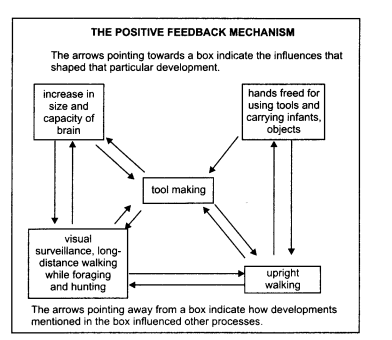Table of Contents
NCERT Solutions for Class 11 History Chapter 1- Early Societies
We shall learn about the earliest cultures from the beginning of time in this chapter. In this chapter, we shall also see the various phases of human origin. The history of human origin from 6 MYA to 1BCE will also be shown. Human development occurs through a number of stages. Of a larger group of animals, primates constitute a subset. Between 36 and 24 million years ago, primates lived in Asia and Africa. Hominoids have existed for about 24 mya.
NCERT Solutions Class 11 History Chapter 1-Early Societies– Solutions PDF
To Download the pdf of Class 11 History NCERT Solutions of Chapter 1, click below.
NCERT Solutions for Class 11 History Chapter 1- Early Societies
NCERT Solutions for Class 11 History Chapter 1-Early Societies– Questions and Answers
ANSWER IN BRIEF
1. Look at the diagram showing the positive feedback mechanism on page 13. Can you list the inputs that went into tool making? What were the processes that were strengthened by tool making?

Following points can be deduced from the positive feedback mechanism:
- Increased brain size and capability, upright walking, and long-range visual surveillance are all factors that assisted in the creation of tools.
Foraging and hunting while walking. - The processes that were boosted by the creation of tools included upright walking, an expansion in brain size and capacity, visual surveillance, and long-distance foraging and hunting walks.
2. Humans and mammals such as monkeys and apes have certain similarities in behaviour and anatomy. This indicates that humans possibly evolved from apes. List these resemblances in two columns under the headings of (a) behaviour and (b) anatomy. Are there any differences that you think are noteworthy?
Ans. Following are the Similarities between the humans and the monkeys:
Behaviour
- Humans and Monkeys (and apes), both can climb trees and hence are of active nature.
- In both Humans and Monkeys (and apes), mother give birth to young ones and have emotional attachment with them.
- Humans as well as Monkeys (and apes), both can walk long distances and they do so in groups.
Anantomy
- Humans and Monkeys (and apes) both are vertebrates.
- Humans and Monkeys (and apes) both are quadrupeds, that means they have two arms and two legs.
3. Discuss the arguments advanced in favour of the regional continuity model of human origins. Do you think it provides a convincing explanation of the archaeological evidence? Give reasons for your answer.
The Regional Continuity Model states that Homo sapiens evolved into modern humans at varying rates in various geographic locations. As a result, modern humans made their initial appearance in various locations around the globe. It was based on geographical variations in contemporary human characteristics. The proponents of this theory discovered that the variations are caused by variations in the populations of Homo erectus and Homo heidelbergensis in the same places. The archaeological evidence is not satisfactorily explained by the Regional Continuity Model.
4. Which of the following do you think is best documented in the archaeological record: (a) gathering, (b) tool making, (c) the use of fire?
The archaeological records provide the finest documentation of tool production methods. The oldest proof of the creation and use of stone tools is found in Ethiopian and Kenyan archaeological sites. The remains of numerous types of tools that were discovered after excavations demonstrate that man had mastered the art of creating tools. Additionally, the size and design of the instruments were altered in accordance with the requirements of the time.
ANSWER IN A SHORT ESSAY
5. Discuss the extent to which (a) hunting and (b) constructing shelters would have been facilitated by the use of language. What other modes of communication could have been used for these activities?
The capacity of the human brain increased with time, which gradually enabled early people to communicate with one another. At first, gesture-based nonverbal communication was the main way of interaction. Following are the ways in which use of language facilitated human life:
(a) Hunting: People are now capable of planning and overseeing hunting missions. They can now freely discuss various creatures found in various places and their various species. Now they could talk about the character and conduct of animals. Now they could talk about the kinds of tools that might be employed.
(b) Constructing Shelters: People may now talk about finding safe and secure locations to build shelters. People might now learn more about the materials that went into building a shelter. It is simple to find out about the resources in and around their environment. They may now talk about how to safeguard their shelters in adverse weather.
There were more forms of communication, including signs, symbols, cave paintings, engravings on cave walls and ceilings, and more.
6. Choose any two developments each from Timelines 1 and 2 at the end of the chapter and indicate why you think these are significant.
Timeline 1: (Choose any one)
(i) About 5.6 mya, the earliest Hominid remains were discovered. Hominoids gave rise to the Hominids. They shared several characteristics. Compared to Hominoids, Hominids have larger brains. Hominids walked upright and moved on two legs. With relation to hand, there was a noticeable difference. It aided them in their tool usage.
(ii) Large portions of the planet were blanketed with snow around 2.5 mya. The ecosystem underwent significant modifications. It caused the grassland to grow.
Timeline 2: (choose any one)
(i) The voicebox underwent development about 200,000 years ago. Now that his voice box had developed, the man was about to talk and share his opinions.
(ii) The earliest examples of burnt clay figurines date back to about 27,000 years ago. The development of sewing machines improved people’s quality of life.
Class 11 History NCERT Book Chapter 1 Notes- Early Societies
NCERT Solutions for Class 11 History Chapter 1-Early Societies– FAQs
Ques. What is the first chapter of history class 11th?
Ans. First chapter of History Class 11th is Early Societies. From the Beginning of time.
Ques. What is the earliest societies?
Ans. Lower Palaeolithic sites have been discovered in India along the Narmada and Soan rivers, which are currently in Pakistan. Between 500,000 and 10,000 BCE was the Palaeolithic Age. People in this time period led nomadic lifestyles.
Ques. Who was Arnold Toynbee class 11 history?
Ans. A well-known philosopher and economist was Arnold Toynbee. “Lectures on the Industrial Revolution in England” is the title of a book he wrote.
Ques. How do early societies differ from another?
Ans. Early societies often adopted an egalitarian structure in which everyone is treated equally. Far more rigorous systems have been devised by other societies. Dynastic rule, which was prevalent in ancient Egypt, is an excellent example.


 KVS Lottery Result 2024 25 Out, Kendriya...
KVS Lottery Result 2024 25 Out, Kendriya...
 CU Result 2024, Calcutta University 5th ...
CU Result 2024, Calcutta University 5th ...
 JAC 10th Result 2024 Link Active, Check ...
JAC 10th Result 2024 Link Active, Check ...














